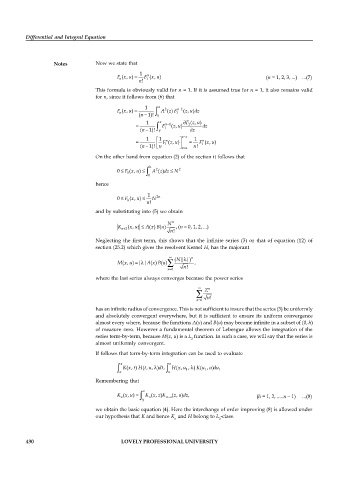Page 437 - DMTH504_DIFFERENTIAL_AND_INTEGRAL_EQUATION
P. 437
Differential and Integral Equation
Notes Now we state that
1 n
x
u
F n ( , ) F 1 ( , ) (n = 1, 2, 3, ...) ...(7)
u
x
! n
This formula is obviously valid for n = 1. If it is assumed true for n = 1, it also remains valid
for n, since it follows from (6) that
1 x
z
x
u
z
F n ( , ) A 2 ( ) F 1 n 1 ( , )dz
u
(n 1)! y
1 x n 1 F 1 ( , )
u
z
u
F 1 ( , ) dz
z
(n 1)! y z
z x
1 1 n 1 n
F 1 ( , ) F 1 ( , )
z
u
x
u
(n 1)! n z u ! n
On the other hand from equation (2) of the section it follows that
h
u
z
x
0 F 1 ( , ) A 2 ( )dz N 2
0
hence
1 2n
u
x
0 F n ( , ) N
! n
and by substituting into (5) we obtain
N n
K n 2 ( , ) A ( ) ( ) , (n 0, 1, 2, ...)
B
x
u
u
x
! n
Neglecting the first term, this shows that the infinite series (3) or that of equation (12) of
section (25.2) which gives the resolvent Kernel H, has the majorant
N
( | |) n
u
B
u
x
M ( , ) | | ( ) ( ) ,
A
x
! n
n 0
where the last series always converges because the power series
Z n
! n
n 0
has an infinite radius of convergence. This is not sufficient to insure that the series (3) be uniformly
and absolutely convergent everywhere, but it is sufficient to ensure its uniform convergence
almost every where, because the functions A(x) and B(u) may become infinite in a subset of (0, h)
of measure zero. However a fundamental theorem of Lebesgue allows the integration of the
series term-by-term, because M(x, u) is a L function. In such a case, we will say that the series is
2
almost uniformly convergent.
If follows that term-by-term integration can be used to evaluate
x x
K
dt
x
t
x
K ( , ) H ( , , ) , H ( , u 1 , ) (u 1 , )du 1
u
t
u
u u
Remembering that
x
dz
x
u
x
z
u
z
K n ( , ) K v ( , )K n v ( , ) , (h = 1, 2, .....n 1) ...(8)
y
we obtain the basic equation (4). Here the interchange of order improving (8) is allowed under
our hypothesis that K and hence K and H belong to L -class.
n 2
430 LOVELY PROFESSIONAL UNIVERSITY

